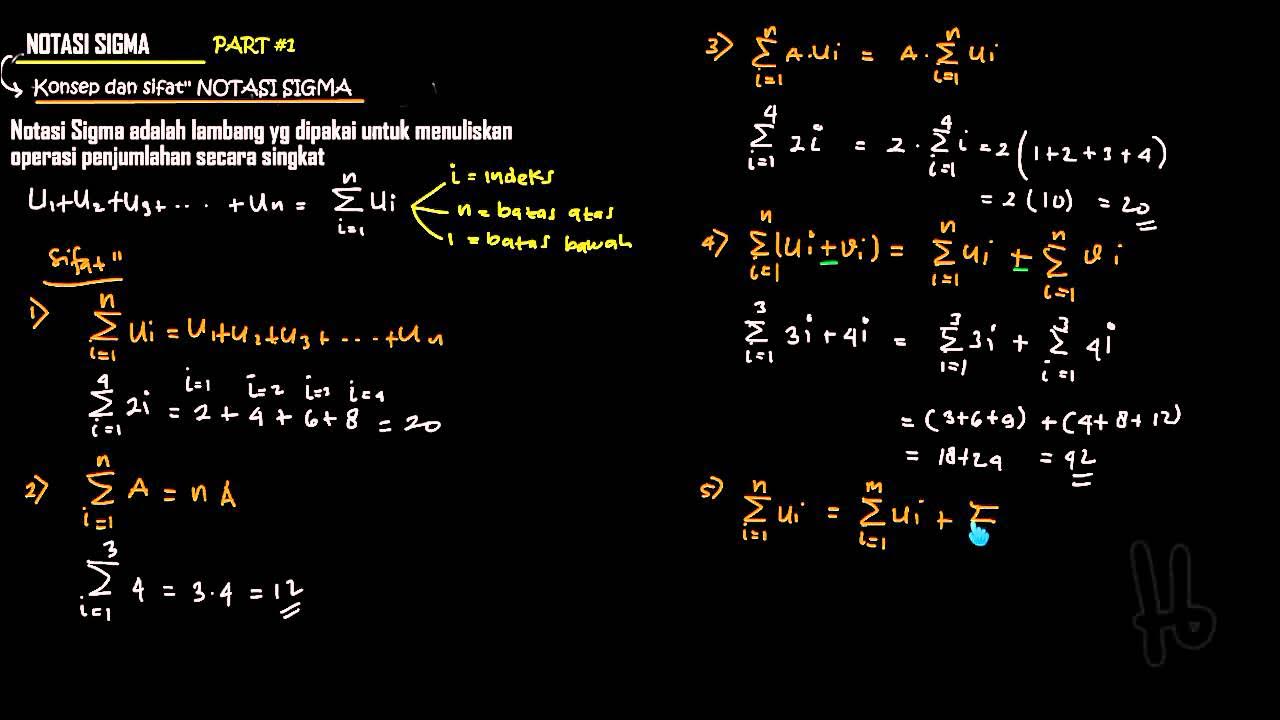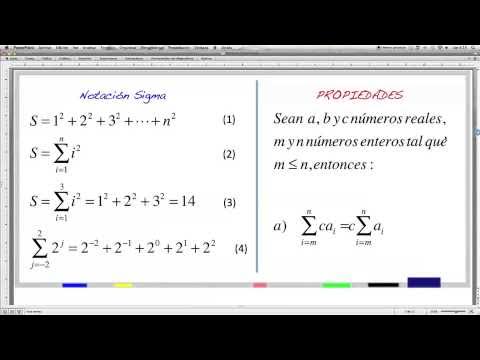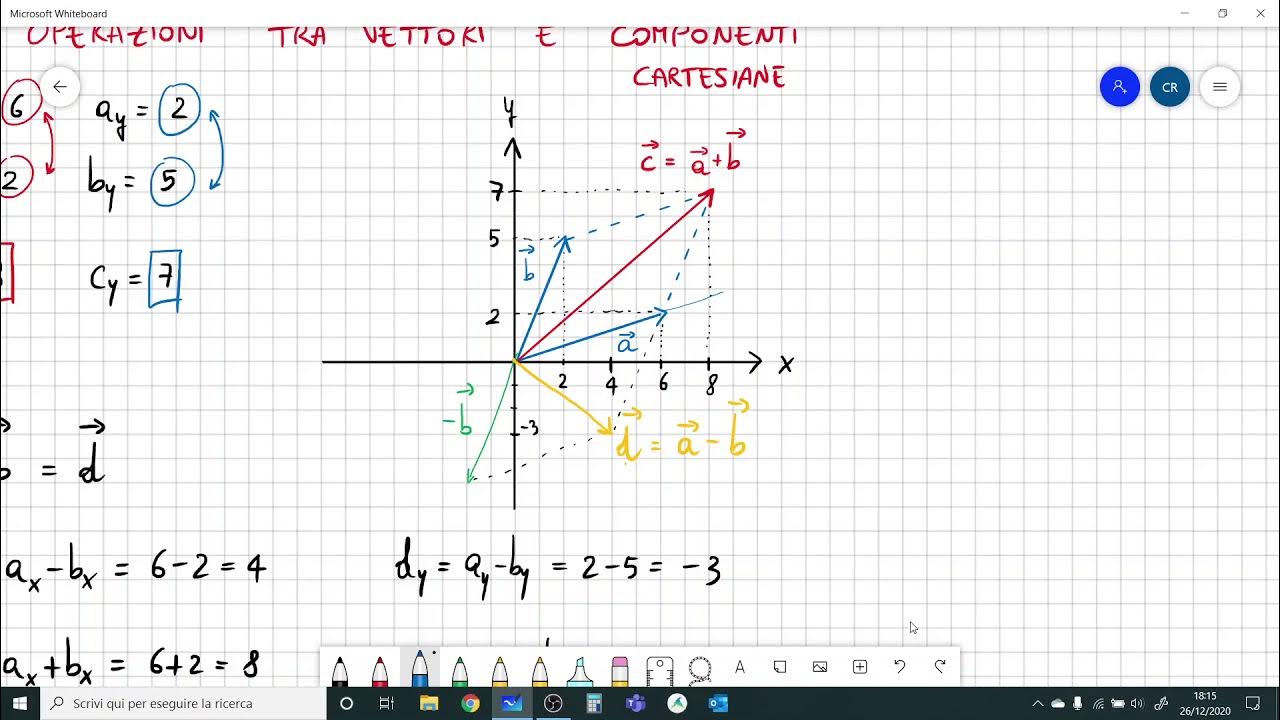Notasi Sigma Matematika Kelas 11 • Part 1: Pengertian Notasi Sigma
Summary
TLDRThis video explains sigma notation in mathematics, focusing on its components and how it simplifies summing sequences. It introduces the Σ symbol as a shorthand for summation, with the variable, limits, and function playing key roles in defining the sum. The video provides examples on converting sigma notation to sequences and vice versa, demonstrating arithmetic and other types of progressions. By the end, viewers will understand how to work with sigma notation for various mathematical problems, from basic sums to more complex series, offering a clear and engaging explanation for learners.
Takeaways
- 😀 Sigma notation represents the sum of a series, indicated by the Greek letter Σ.
- 😀 The variable under the sigma symbol (e.g., 'n') is the index of summation, starting at a lower limit and ending at an upper limit.
- 😀 Sigma notation helps simplify long series by representing them concisely using a function and its limits.
- 😀 The limits in sigma notation are integers and specify where the summation starts (lower limit) and ends (upper limit).
- 😀 The function inside sigma notation defines how each term in the series is calculated based on the variable (e.g., n^2, 3n-1).
- 😀 To convert a series into sigma notation, recognize the pattern in the terms and the starting and ending values of the index.
- 😀 For example, Σ from n=1 to 5 of n^2 represents the sum of squared numbers from 1 to 5.
- 😀 When converting sigma notation to a series, substitute the values of the variable (e.g., n=1, n=2) into the function.
- 😀 Sigma notation can represent arithmetic sequences, where the difference between terms remains constant.
- 😀 To express a series with a known pattern (e.g., 2n + 8), identify the function and limits to convert it into sigma notation.
Q & A
What is Sigma notation and what does it represent in mathematics?
-Sigma notation (Σ) is a shorthand used to represent the summation of a series of terms following a particular pattern. It simplifies writing long sums and makes it easier to express sums in a compact form.
What are the main components of Sigma notation?
-The main components of Sigma notation are: Σ (indicating summation), the index variable (like 'n'), the lower limit (where the sum starts), the upper limit (where the sum ends), and the function or expression (such as n²) that defines the terms in the series.
What does the 'n = p' and 'k' in Sigma notation represent?
-'n = p' represents the lower limit or starting value of the summation index, while 'k' represents the upper limit, or where the summation ends. These limits help define the range of terms to sum over.
How do you convert Sigma notation into a series?
-To convert Sigma notation into a series, substitute the values of the index variable (n) from the lower limit to the upper limit into the given function, and write out each term in the series. For example, Σ from n = 1 to 5 of n² becomes 1² + 2² + 3² + 4² + 5².
Can the index variable in Sigma notation be anything other than 'n'?
-Yes, the index variable in Sigma notation can be any letter or symbol, such as 'n', 'k', or 'p', depending on the context or problem.
What is the difference between the lower limit and upper limit in Sigma notation?
-The lower limit in Sigma notation is the starting point of the summation, while the upper limit is the endpoint. The sum includes all terms from the lower limit to the upper limit.
What is an arithmetic series, and how does Sigma notation represent it?
-An arithmetic series is a sequence of numbers where each term differs from the previous one by a constant value (called the common difference). Sigma notation can represent such series with a linear expression, like 2n + 8, where the difference between terms is constant.
What is a square series (Deret Kuadrat), and how is it expressed in Sigma notation?
-A square series involves terms that are squares of integers, such as n². In Sigma notation, a square series can be represented as Σ from n = 1 to 5 of n², meaning you sum the squares of numbers from 1 to 5.
How do you convert a series like 10, 12, 14, 16 into Sigma notation?
-This series follows a pattern of adding 2 to each term. It can be expressed in Sigma notation as Σ from n = 1 to 4 of (2n + 8), where each term is 2 times the index (n) plus 8.
How can you express a series that includes both squares and constants, like 1, 2, 3, 4?
-For a series with both squares and constants, such as 1, 2, 3, 4, expressed as n² + n, the Sigma notation would be Σ from n = 1 to 4 of (n² + n), where n starts at 1 and ends at 4, and each term is the sum of n squared and n.
Outlines

このセクションは有料ユーザー限定です。 アクセスするには、アップグレードをお願いします。
今すぐアップグレードMindmap

このセクションは有料ユーザー限定です。 アクセスするには、アップグレードをお願いします。
今すぐアップグレードKeywords

このセクションは有料ユーザー限定です。 アクセスするには、アップグレードをお願いします。
今すぐアップグレードHighlights

このセクションは有料ユーザー限定です。 アクセスするには、アップグレードをお願いします。
今すぐアップグレードTranscripts

このセクションは有料ユーザー限定です。 アクセスするには、アップグレードをお願いします。
今すぐアップグレード5.0 / 5 (0 votes)






